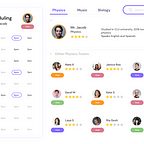Designing a Tutoring App for GenZ?
What do the post pandemic era students expect from their interface for education? A Case Study.
Duration: 5 Days
A huge majority of students have shifted to the digital tutoring platforms recently because of a number of benefits including the availability of highly trained professionals who would otherwise be too remote.
Design Brief
Designing a tutoring app that aims to address this problem by providing on-demand, personalized tutoring to students who need it, at a price point that is affordable for all.
By connecting students with qualified tutors who are available to offer help when and where it is needed, our app will enable students to get the support they need to succeed in their courses and achieve their academic goals.
I wanted to make the interface as seamless and simple and ensure that there is zero cognitive load on the students and their only task at hand has to be attending classes, finishing homework and collecting points.
Link to Figma Prototype
I attempted to keep things simple; keeping in mind my user is a school going student and tried to make all the features accessible. I worked on the UI after blocking in the Low fidelity screens.
Discover
I dove right in with some Desk Research and stakeholder mappling. There were some good UX Case studies that I reffered, and after gaining some context, I started brain-storming on the painpoints of these designs.
A Nav Map of White Hat Jr, helped me get a jist of how these services function.
I went into stakeholder analysis in more detail. These would be Teachers, Parents and Kids, Owner and team involving and identifying and evaluating the various groups of people who have an interest in or are impacted by the app.
These stakeholders can be grouped into several categories, including:
- Users: These include students, teachers, and parents who will be using the app to access educational content and resources.
- Investors: These include venture capitalists, angel investors, and other financial backers who have invested money in the app.
- Developers: These include the individuals and teams responsible for creating and maintaining the app.
- Educational institutions: These include schools and universities that may use the app as part of their curriculum.
- Competitors: These include other e-tutoring apps or educational technology companies that may offer similar services.
I evaluated the needs, expectations, and potential impact of each group of stakeholders.
For example, I found users may prioritize ease of use and a wide range of educational content, while investors may focus on financial return and scalability.
Competitive Analysis- White Hat and Khan Academy
WhiteHat Jr. is an Indian edtech company that provides online coding classes for children. The company that their curriculum is designed to help children develop problem-solving, logical thinking and creativity skills.
Khan Academy is a nonprofit educational organization that provides free online educational resources. The organization has expanded to offer a wide range of educational resources, including video lessons, practice exercises, and assessments in subjects such as math, science, history, and economics. It’s also used by many schools and educational institutions as a supplement to their curriculum.
I asked one of the students if I can borrow their dashboards to understand what goes on in there.
Task flow analysis
Feature Listing
Wireframes- Lo- Fi
Typography
Final Designs
Learnings
It was quite a challenge to complete this project within five days of recieving the design brief, but it was also a great learning experience.
A great tool that I leveraged in this project was systems thinking, as I was able to break down and compartmentalise my work into digetsable bits of information that really helped me keep pace with my timeline.
